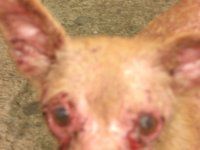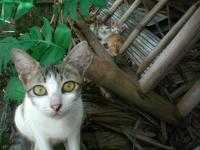Nutrition The Raw Truth
Sponsored Links
There have been some interesting developments in the area of dog and cat nutrition in the mainstream
of research. Although not a surprise to me, I am delighted to report that the findings are very compatible with my personal recommendations. (The only difference is that the researchers probably spent hundreds of thousands of dollars to figure out what I learned watching the Discovery channel.) Colorado State University College of Veterinary Medicine's Department of Oncology (cancer research) has found that high carbohydrate diets are conducive to the growth of tumors and should be avoided in dogs and cats with cancer. They recommend diets high in protein and fat. A major pet food manufacturer has begun an advertising campaign for their new food for senior dogs. Their contention is that older dogs do better with more protein than previously thought. The higher protein level increases energy and vitality.
If one understands that by nature carnivores eat a high protein, low carbohydrate diet, the results of these studies could have been easily anticipated. Based on my understanding of carnivore nutrition, these have been my recommendations for several years. The main difference being that I don't wait until a pet produces a tumor or reaches a certain age to implement the proper feeding program. I strongly believe that my dietary recommendations have increased the quality and perhaps the quantity of life of many pets with cancer (and many other conditions) as well as many older pets. Unfortunately the pet food manufacturers will likely never succeed in producing a truly healthful diet. The reasons for which I hope the rest of this article will make clear.
When I graduated from veterinary school, I thought I knew a lot about health and disease. I was half right. I learned a great deal about disease. I was taught pitifully little about health. Removing symptoms and restoring health are not the same. Drugs and surgery eliminate symptoms yet they weaken the body further, resulting in chronic conditions. As a result of such medical practices, the health of our pets is getting worse. More chronic diseases ranging from allergies to cancer afflict our beloved companions than ever before. The use of processed pet foods plays a major role in this trend. By nature, dogs and cats are designed to eat other animals such as birds, rabbits and squirrels. This means that their natural diet consists primarily of animal tissues namely, meat, organs, glands, bones and a small amount of vegetable matter found in the intestinal tract of prey. In addition, all of these ingredients are only eaten in the raw state. Raw foods contain enzymes that assist in digestion and absorption of nutrients. It is only in the past few decades that dogs and cats have been given cooked foods.
When raw foods are processed into pet foods, the molecular structure is altered and enzymes are destroyed. These changes make them difficult to digest. The result is stress on the digestive system, especially the pancreas. Stress on the immune system occurs as a result of absorbing incompletely digested foods which stimulate the body's defenses. Canned, dry and home cooked foods produce these detrimental effects. The best quality nutrition for dogs and cats is all raw foods, the way nature intended. The risks associated with feeding raw meat e.g. salmonella are easily outweighed by the benefits. Healthy carnivores are naturally able to deal with germs and parasites. Currently, there are thousands of dogs and cats on raw foods around the world, yet I have not heard of one case of salmonella as a result. The long term risk of chronic disease does not make the use of processed foods worthwhile. I have used the following recipe in virtually all of my patients over the past 2—3 years with impressive results.
This is approximately the amount of food needed to feed a pet weighing 15—30 lbs. Adjust the amount according to the size of your pet and his or her individual needs. Generally, one meal daily is adequate if the pet is allowed to eat its fill. I use the same formula for dogs, cats and ferrets.
Recipe
1/2 lbs. raw beef, chicken, lamb, turkey, venison, occasionally seafood or eggs
1/4 tsp. powdered kelp or other sea vegetables
rounded 1/2 tsp. EggShellent Calcium
1/2 cup pureed raw veggie mix: carrots, zucchini, sprouts, broccoli, celery, parsley, cucumber, beets, other green leaves
1/2 tsp. of spirulina, barley powder, wheat grass juice powder, bee pollen or green food supplement such as PetiGreens
In addition to the above mandatory ingredients, there are three strongly suggested supplements.
1. A high potency digestive supplement containing digestive enzymes and digestive bacteria
2. A supplement containing a variety of gland and organ concentrates
3. A liquid, ionic trace mineral supplement
Some pets need additional oil in their diet. If your pet does, try 1/2 — 1 teaspoon of high quality fish oil.
If stools are too firm with the above recipe, try adding one of the following items: 1 teaspoon wheat bran, 1/2 teaspoon ground flax seed or ground psyllium seed.
Leave meat in large chunks. Initially, you may need to use ground or diced meat to help pet adjust. A piece of organic liver is advised 1—2 times per week. If your pet is sensitive to diet changes, start with small amounts of raw foods and increase slowly. Food may be made in batches and frozen. RAW bones are important for healthy teeth (see dentistry article). To introduce bones, allow your pet to have one for 10—15 minutes every few days and observe digestive function. Increase access time as pet adapts.
Don't forget to always have fresh purified water available. If using distilled or reverse osmosis water, add liquid ionic trace minerals. The preceding recipe is not meant to replace consultation with a competent professional. Raw food diets entail certain risks (but so do pet foods!!)
Holistic veterinarians seek to strengthen pets, enabling them to heal themselves. The first step is almost too obvious: FEED PROPERLY! Pets need a natural feeding program rich in raw foods and enzymes. NO pet food is 100% complete. (Most aren't even close!!) Your pet deserves better! Your pet will look and feel better and your vet bills will decrease significantly.
This recipe is for informational purposes. It is not intended to replace consulting with a professional. Raw food diets entail certain risks (so do processed pet foods!)
- Russell Swift, DVM, Classical Homeopath
Feel Free To Read Another Article
Feel free to read another article or continue exploring the rest of my web site. Remember, you can also visit my question and answers also.
- Holistic Pet Health Articles
- Introduction To Natural Health And Nutrition For Pets
- Nutrition — The Raw Truth
- The Real Poop On Inflammatory Bowel Disease
- Chronic Renal Failure
- Clearing The Air About Flatulence
- Weight Loss: Is Your Pet Ready For Bikini Season?
- Seizure Disorders And Homeopathy
- Homeopathy And Behavioral Problems
- Vegetarian Feeding Of Dogs And Cats
- Pet Allergies
- Thunder and Lightning, Very Frightening, Or Not?
- Blood Tests: But The Tests Were Okay!
- Pet Dentistry: Filling You In On Dental Care
- Holistic Healing: Commitment or Commodity?
- Rimadyl — Wolf In Sheep's Clothing
- Flea Free Naturally
- Of Worms and Germs
- Not All That Itches Are Fleas
- Effects Of Symptom Suppression
- A Homeopath's Perspective On Topical Therapy
- Genes And Proteins: The Stuff Of Life
- Miasms — A Modern Understanding
- Vaccines — Good Medicine Or Bad Advice?
- Herings Law of Healing
- Causes Of Symptoms
- About Dr. Swift, DVM
 Meet Jumbo, the participant in
Meet Jumbo, the participant in 